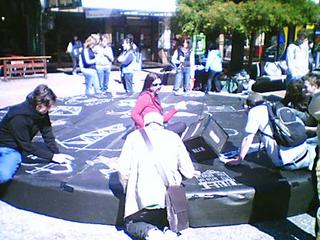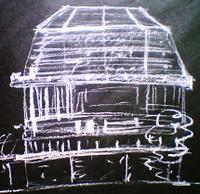Chalk, coffee and concrete
My brain's still recovering from a weekend full of architecture-related activities (and some cocktail-related ones), but I'll try to do a concise wrap-up of the last two days of Wellington Architecture Week.

Saturday was the climax of the week (World Architecture Day), and the most visible manifestation of this was Draw Wellington. At five sites throughout the city, students were given white chalk, string and rolls of black drawing paper, then asked to create an installation that would help the public engage with and draw the built environment around them.
 The results included paper scaffolding on the City to Sea bridge and a cascade of paper down the cutout and into the water at the Taranaki Wharf cutout. But my favourite was in Courtenay Place, where the students covered the band platform in paper and created dice for the public to throw. Participants then had to draw something nearby that matched the attributes on the dice ("ugly", "above you", "something to sit on"). My random attribute was "grey", which gave me an opportunity to sketch one of my favourite buildings, the Hannah Playhouse. The resulting scrawl is a good reminder of why I was wise not to pursue a career in architecture or art.
The results included paper scaffolding on the City to Sea bridge and a cascade of paper down the cutout and into the water at the Taranaki Wharf cutout. But my favourite was in Courtenay Place, where the students covered the band platform in paper and created dice for the public to throw. Participants then had to draw something nearby that matched the attributes on the dice ("ugly", "above you", "something to sit on"). My random attribute was "grey", which gave me an opportunity to sketch one of my favourite buildings, the Hannah Playhouse. The resulting scrawl is a good reminder of why I was wise not to pursue a career in architecture or art.After dashing around these sites and several open offices (including Architecture Workshop, of which there'll be more later), I just made it to Parsons in time for Latte, Lunch and Harry. Actually, there was no latte, but the perked coffee was more in keeping with the original 1950s coffee culture that the event was celebrating. Tommy Honey and Redmer Yska provided comments and anecdotes about the civilising influence that Harry Seresin and other "refos" brought to grey old Anglo-Saxon Wellington, but one of the things that made this event special was the extent to which Honey and Yska also learnt from the audience, many of whom had been part of the scene at the time.
I asked them about who would be looked back on as the Harry of today, someone who had helped create welcoming venues where the social and creative life of the city could thrive. I had to agree with Honey's answer that Tim Rose and Geoff Marsland (of Midnight Espresso, Deluxe and Havana fame) were good candidates.
Sunday saw a chance of pace, with an expedition into deepest Lower Hutt for Ian Bowman's tour of 1950s buildings. The modernist buildings of the Civic Centre are already quite well known, to the extent that Hutt City council is starting to use them in a semi-ironic billboard campaign, though not to the extent that there is any heritage protection for them or any mention on their historic buildings page. The council buildings are perhaps the most attractive of these, though to my eye the clock tower gives it a look that is more art deco or moderne than strictly modernist.
 Less well known are commercial buildings of the era, such as the CML building pictured here. While I think that Bowman's comparison of this to Chelsea's Peter Jones department store is a bit of a stretch, the curved corners do address the street nicely and the addition of a vertical section breaks up what could have been a repetitive façade.
Less well known are commercial buildings of the era, such as the CML building pictured here. While I think that Bowman's comparison of this to Chelsea's Peter Jones department store is a bit of a stretch, the curved corners do address the street nicely and the addition of a vertical section breaks up what could have been a repetitive façade.While the Modern Movement gave Lower Hutt a legacy of quality buildings, it also blighted it with the town planning ethos of the era. The high Modernist distaste for the street is evident in the Civic Centre, which is designed as a set of isolated buildings in a twee little park, with no sense of spatial definition, shelter or street life. The post-war car culture has also left its mark, with a busy roundabout next to the park, and of course the centre itself is about as far as you can get from either of the Hutt's railway lines. It's a pity that later additions to St James' church have blocked the gap between the tower and the main building. It used to be possible to drive through this gap, and what could be more symbolic of Lower Hutt than a drive-thru church?



0 Comments:
Post a Comment
<< Home